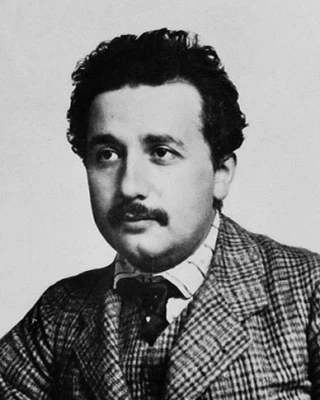
Image description: It took a rebellious, young, revolutionary, and nonconformist mind to renounce the achievements of the physics of his peers. Albert Einstein (1879-1955) conducted an analysis of the concept of time. There is no great universal clock, that is what his theory tells. Albert Einstein obtained his doctorate on January 15, 1906. His fame would only emerge in 1909. He received the Nobel Prize in Physics in 1921.
We know the importance of the results obtained by Einstein in 1905 regarding the properties of matter, energy, space, and time. Albert Einstein was born on March 14, 1879, in Ulm, a medium-sized city in Württemberg, Germany. In 1905, he published in the German journal "Annalen der Physik" four articles that revolutionized 20th-century physics.
"On a Heuristic Point of View Concerning the Production and Transformation of Light".
The article by Albert Einstein, titled "Über einen die Erzeugung und Verwandlung des Lichtes betreffenden heuristischen Gesichtspunkt," is one of the foundational works of modern physics, particularly quantum theory. This article offers a new perspective on the nature of light and introduces the revolutionary idea that light might be composed of "quanta," discrete packets of energy, now called photons.
N.B.:
The term "heuristic" refers to an approach to discovery or understanding that relies on intuition, experience, or methods that are not strictly formal. It indicates a research path toward which there is something to be found.
• Available in English and French.
"On the Movement of Particles Suspended in a Stationary Fluid as Inferred from the Kinetic Molecular Theory of Heat".
The article by Albert Einstein discusses Brownian motion, which was described by the botanist Robert Brown (1773-1858) in 1827. This phenomenon concerns the random motion of small particles suspended in a liquid, and Einstein proposes in this article an explanation based on the kinetic theory of gases.
N.B.:
Brownian motion was first described in 1827. Robert Brown (1773-1858), a Scottish naturalist, observed in nature that stones contain water in which there are pollen grains. These pollen grains move while they have been trapped for millions of years. How is it that these pollen grains move? That is Brownian motion. Einstein explains this Brownian motion through molecular and atomic hypotheses and calculates the size of molecules.
"On the Electrodynamics of Moving Bodies".
The article by Albert Einstein titled "Zur Elektrodynamik bewegter Körper" is one of the most influential works in modern physics. In it, he introduces what will become the theory of special relativity. In this article, Einstein resolves several paradoxes and inconsistencies of classical physics by redefining the concepts of time, space, and motion while preserving Maxwell's equations for electromagnetism.
• Available in French (under CC-BY-SA license).
"Does the Inertia of a Body Depend on Its Energy Content?".
The article by Albert Einstein, "Ist die Trägheit eines Körpers von seinem Energieinhalt abhängig?", also published in the German journal "Annalen der Physik," is a concise yet extremely influential text that introduces the famous relationship between mass and energy: E=mc². This article arises from Einstein's work on special relativity and examines how the energy of a body is related to its inertia, i.e., its resistance to acceleration.
The articles from 1905 by Einstein not only revolutionized physics but also had a lasting impact on how we understand the natural world, affecting various scientific and technological fields. They established Einstein as one of the major figures in 20th-century science.